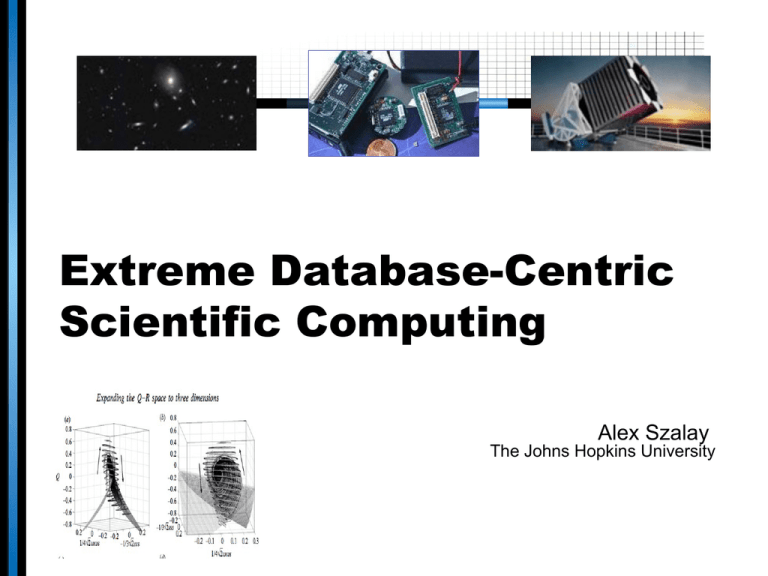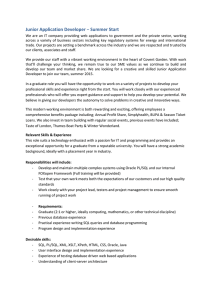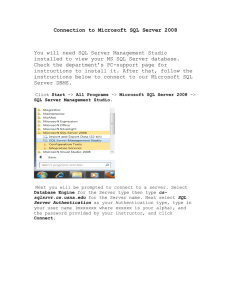Extreme Database-Centric Scientific Computing Alex Szalay The Johns Hopkins University
advertisement

Extreme Database-Centric
Scientific Computing
Alex Szalay
The Johns Hopkins University
Scientific Data Analysis Today
•
•
•
•
•
•
•
•
•
•
Scientific data is doubling every year, reaching PBs
Data is everywhere, never will be at a single location
Architectures increasingly CPU-heavy, IO-poor
Data-intensive scalable architectures needed
Databases are a good starting point
Scientists need special features (arrays, GPUs)
Most data analysis done on midsize BeoWulf clusters
Universities hitting the “power wall”
Soon we cannot even store the incoming data stream
Not scalable, not maintainable…
Gray’s Laws of Data Engineering
Jim Gray:
•
•
•
•
•
Scientific computing is revolving around data
Need scale-out solution for analysis
Take the analysis to the data!
Start with “20 queries”
Go from “working to working”
Sloan Digital Sky Survey
•
•
“The Cosmic Genome Project”
Two surveys in one
–
–
•
•
Started in 1992, finished in 2008
Data is public
–
–
–
•
Photometric survey in 5 bands
Spectroscopic redshift survey
2.5 Terapixels of images
40 TB of raw data => 120TB processed
5 TB catalogs => 35TB in the end
Database and spectrograph
built at JHU (SkyServer)
The University of Chicago
Princeton University
The Johns Hopkins University
The University of Washington
New Mexico State University
Fermi National Accelerator Laboratory
US Naval Observatory
The Japanese Participation Group
The Institute for Advanced Study
Max Planck Inst, Heidelberg
Sloan Foundation, NSF, DOE, NASA
Visual Tools
•
Goal:
–
–
•
Challenge:
–
–
–
–
•
Images: 200K x 2K x1.5K resolution x 5 colors = 3 Terapixels
300M objects with complex properties
20K geometric boundaries and about 6M ‘masks’
Need large dynamic range of scales (2^13)
Assembled from a few building blocks:
–
–
–
•
Connect pixel space to objects without typing queries
Browser interface, using common paradigm (MapQuest)
Image Cutout Web Service
SQL query service + database
Images+overlays built on server side -> simple client
Same images in World Wide Telescope and Google Sky
Geometries and Spatial Searches
•
SDSS has lots of complex boundaries
–
•
•
•
•
60,000+ regions, 6M masks as spherical polygons
A GIS-like indexing library built in C++, using
spherical polygons, and quadtrees (HTM)
Lots of computational geometry added in SQL!
Now converted to C# for direct plugin into DB
Using spherical quadtrees (HTM) + B-Tree
=> space filling curve in 2D
Indexing with Spherical Quadtrees
•
•
•
•
•
•
•
Cover the sky with hierarchical pixels
Hierarchical Triangular Mesh (HTM) uses trixels
Start with an octahedron, and
split each triangle into 4 children,
down to 24 levels deep
Smallest triangles are 5 milliarcsec
For each object in DB we compute htmID
Each trixel is a unique range of htmIDs
Maps onto DB range searches (B-tree)
Public Use of the SkyServer
•
Prototype in 21st Century data access
–
–
–
–
–
•
820 million web hits in 9 years
1,000,000 distinct users
vs 10,000 astronomers
Delivered 50,000 hours
of lectures to high schools
Delivered 100B rows of data
Everything is a power law
GalaxyZoo
–
–
–
–
40 million visual galaxy classifications by the public
Enormous publicity (CNN, Times, Washington Post, BBC)
300,000 people participating, blogs, poems, ….
Now truly amazing original discovery by a schoolteacher
Astronomy Survey Trends
T.Tyson (2010)
9
SDSS
2.4m 0.12Gpixel
LSST
8.4m 3.2Gpixel
PanSTARRS
1.8m 1.4Gpixel
Impact of Sky Surveys
Continuing Growth
How long does the data growth continue?
•
•
High end always linear
Exponential comes from technology + economics
–
–
•
•
•
rapidly changing generations
like CCD’s replacing plates, and become ever cheaper
How many generations of instruments are left?
Are there new growth areas emerging?
Software is becoming a new kind of instrument
–
–
–
Value added federated data sets
Large and complex simulations
Hierarchical data replication
Cosmological Simulations
Cosmological simulations have 109 particles and
produce over 30TB of data (Millennium)
•
Build up dark matter halos
•
Track merging history of halos
•
Use it to assign star formation history
•
Combination with spectral synthesis
•
Realistic distribution of galaxy types
•
•
•
Hard to analyze the data afterwards -> need DB
What is the best way to compare to real data?
Next generation of simulations with 1012 particles
and 500TB of output are under way (Exascale-Sky)
Immersive Turbulence
•
Understand the nature of turbulence
–
–
–
•
Consecutive snapshots of a
1,0243 simulation of turbulence:
now 30 Terabytes
Treat it as an experiment, observe
the database!
Throw test particles (sensors) in from
your laptop, immerse into the simulation,
like in the movie Twister
New paradigm for analyzing
HPC simulations!
with C. Meneveau, S. Chen (Mech. E),
G. Eyink (Applied Math), R. Burns (CS)
Sample Applications
Experimentalists testing PIV-based pressure-gradient measurement
(X. Liu & Katz, 61 APS-DFD meeting, November 2008)
Measuring velocity gradient using a new set of 3 invariants
Luethi, Holzner & Tsinober,
J. Fluid Mechanics 641, pp. 497-507 (2010)
Lagrangian time correlation in turbulence
Yu & Meneveau
Phys. Rev. Lett. 104, 084502 (2010)
Life Under Your Feet
•
Role of the soil in Global Change
–
–
•
Soil CO2 emission thought to be
>15 times of anthropogenic
Using sensors we can measure it
directly, in situ, over a large area
Active Carbon Storage and
CO2 Emissions
5.4
120
60
68
Wireless sensor network
–
Use 100+ wireless computers (motes),
with 10 sensors each, monitoring
•
•
–
–
–
Air +soil temperature, soil moisture, …
Few sensors measure CO2 concentration
Long-term continuous data, 180K sensor days, 30M samples
Complex database of sensor data, built from the SkyServer
End-to-end data system, with inventory and calibration databases
with K.Szlavecz (Earth and Planetary), A. Terzis (CS)
http://lifeunderyourfeet.org/
90
88
1000
Cumulative Sensor Days
Commonalities
•
Huge amounts of data, aggregates needed
–
–
•
Usage patterns enormously benefit from indexing
–
–
–
–
–
•
•
But also need to keep raw data
Need high levels of parallelism
Rapidly extract small subsets of large data sets
Geospatial everywhere
Compute aggregates
Fast sequential read performance is critical!!!
But, in the end everything goes…. search for the unknown!!
Fits DB quite well, but no need for transactions
Design pattern: class libraries wrapped in SQL UDF
–
Take analysis to the data (to the backplane of the DB)!!
DISC Needs Today
•
•
Disk space, disk space, disk space!!!!
Current problems not on Google scale yet:
–
–
•
Sequential IO bandwidth
–
•
If not sequential for large data set, we cannot do it
How do can move 100TB within a University?
–
–
–
•
10-30TB easy, 100TB doable, 300TB really hard
For detailed analysis we need to park data for several months
1Gbps
10 days
10 Gbps
1 day (but need to share backbone)
100 lbs box few hours
From outside?
–
Dedicated 10Gbps or FedEx
Tradeoffs Today
Stu Feldman: Extreme computing is about tradeoffs
Ordered priorities for data-intensive scientific computing
1.
2.
3.
4.
5.
Total storage (-> low redundancy)
Cost
(-> total cost vs price of raw disks)
Sequential IO (-> locally attached disks, fast ctrl)
Fast stream processing (->GPUs inside server)
Low power (-> slow normal CPUs, lots of disks/mobo)
The order will be different in a few years...and scalability
may appear as well
Increased Diversification
One shoe does not fit all!
•
Diversity grows naturally, no matter what
•
Evolutionary pressures help
–
–
–
–
–
•
•
•
Large floating point calculations move to GPUs
Fast IO moves to high Amdahl number systems
Large data require lots of cheap disks
Stream processing emerging
noSQL vs databases vs column store etc
Individual groups want subtle specializations
Larger systems are more efficient
Smaller systems have more agility
GrayWulf
•
•
•
•
•
•
•
•
Distributed SQL Server cluster/cloud w.
50 Dell servers, 1PB disk, 500 CPU
Connected with 20 Gbit/sec Infiniband
10Gbit lambda uplink to UIC
Funded by the Moore Foundation,
and Microsoft Research
Dedicated to eScience, provide
public access through services
Linked to 1600 core BeoWulf cluster
70GBps sequential IO bandwidth
Cost of a Petabyte
From backblaze.com
Aug 2009
JHU Data-Scope
•
•
•
•
Funded by NSF MRI to build a new ‘instrument’ to look at data
Goal: 102 servers for $1M + about $200K switches+racks
Two-tier: performance (P) and storage (S)
Large (5+PB), cheap , fast (400+GBps), but …
.
...it is a special purpose instrument...
1P
1S
90P
12S
Full
servers
1
1
90
12
102
rack units
4
12
360
144
504
capacity
24
252
2160
3024
5184
TB
price
8.5
22.8
766
274
1040
$K
power
1
1.9
94
23
116
kW
GPU
3
0
270
0
270
TF
seq IO
4.0
3.8
360
45
405
GBps
netwk bw
10
20
900
240
1140
Gbps
Proposed Projects at JHU
Discipline
data [TB]
8
7
Astrophysics
930
HEP/Material Sci.
394
5
CFD
425
3
BioInformatics
414
2
Environmental
660
0
Total
2823
6
4
1
10
20
40
80
160
320
data set size [TB]
A total of 19 projects proposed for the Data-Scope, more
coming, data lifetimes on the system between 3 mo and 3 yrs
640
Cyberbricks?
•
36-node Amdahl cluster using 1200W total
–
–
•
Aggregate disk space 43.6TB
–
–
–
•
•
•
Zotac Atom/ION motherboards
4GB of memory, N330 dual core Atom, 16 GPU cores
63 x 120GB SSD
= 7.7 TB
27x 1TB Samsung F1 = 27.0 TB
18x.5TB Samsung M1= 9.0 TB
Blazing I/O Performance: 18GB/s
Amdahl number = 1 for under $30K
Using the GPUs for data mining:
–
–
6.4B multidimensional regressions
in 5 minutes over 1.2TB
Ported RF module from R in C#/CUDA
Szalay, Bell, Huang, Terzis, White (Hotpower-09)
More GPUs
•
•
•
•
•
•
•
•
Hundreds of cores – 100K+ parallel threads!
Forget the old algorithms, built on wrong assumptions
CPU is free, RAM is slow
Amdahl’s first Law applies
GPU has >50GB/s bandwidth
Still difficult to keep the cores busy
How to integrate it with data intensive computations?
How to integrate it with SQL?
Extending SQL Server
•
User Defined Functions in DB execute inside CUDA
–
•
100x gains in floating point heavy computations
Dedicated service for direct access
–
Shared memory IPC w/ on-the-fly data transform
Richard Wilton and Tamas Budavari (JHU)
SQLCLR Out-of Process Server
•
The basic concept
–
–
•
Implement computational functionality in a separate process
from the SQL Server process
Access that functionality using IPC
Why
–
–
–
–
SQL Server
Out-of-process server
Avoid memory, threading, and
SQL code
Special-case
+SQLCLR
permissions restrictions on
functionality
IPC
procedure or
SQLCLR implementations
function
Load dynamic-link libraries
Invoke native-code methods
Exploit lower-level APIs (e.g. SqlClient, bulk insert) to move
data between SQL Server and CUDA
declare @sql nvarchar(max)
set @sql = N'exec SqA1.dbo.SWGPerf @qOffset=311, @chrNum=7, @dimTile=128'
exec dbo.ExecSWG @sqlCmd=@sql, @targetTable='##tmpX08'
Arrays in SQL Server
•
•
•
•
SQLArray datatype: recent effort by Laszlo Dobos
Written in C++
Arrays packed into varbinary(8000) or varbinary(max)
Various subsets, aggregates, extractions and
conversions available in T-SQL
SELECT s.ix, DoubleArray.Avg(s.a)
INTO ##temptable
FROM DoubleArray.Split(@a,Int16Array.Vector_3(4,4,4)) s
SELECT @subsample = DoubleArray.Concat_N('##temptable')
@a is an large array of doubles with 3 indices
The first command averages the array over 4×4×4 blocks,
returns indices and the value of the average into a table
Then we build a new (collapsed) array from its output
Summary
•
Large data sets are here, solutions are not
–
•
•
•
No real data-intensive computing facilities available
Even HPC projects choking on IO
Cloud hosting currently very expensive
–
•
Commercial cloud tradeoffs different from science needs
Scientists are “frugal”, also pushing the limit
–
–
–
•
100TB is the current practical limit
We are still building our own…
We see campus level aggregation
May become the gateways to future cloud hubs
Increasing diversification built out of commodity parts
–
GPUs, SSDs
Challenge Questions
•
•
What science application would be ideal for the
cloud?
What science application would not work at all in the
cloud?
Think about them and let us discuss tomorrow





